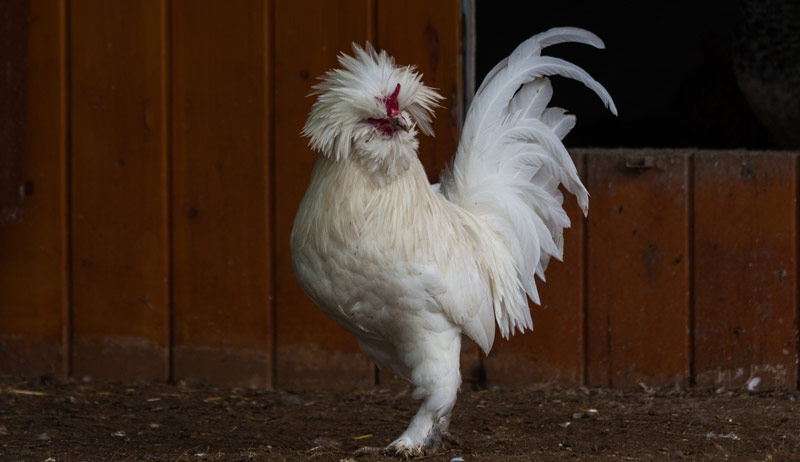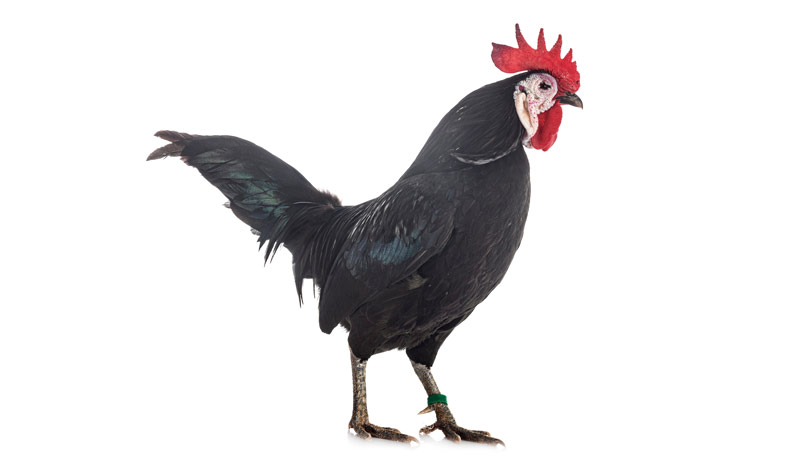
While most flock keepers choose their chickens for egg production, meat or companionship, some select birds solely for appearance. Keeping ornamental poultry is a centuries-old hobby, with fowl fanciers from 6th-century Chinese Emperor Gao Wei to 19th-century British Queen Victoria creating special spaces for their avian collections.
Keeping ornamental birds isn’t just a royal hobby, however. Anybody who admires the delicate, natural beauty of these charming chickens can create and maintain an ornamental aviary.
Most North American chicken breeds, however, were developed to be dual-purpose birds. As a young country, the United States opted for practicality versus aesthetic in the coop. As a result, the majority of ornamental poultry found in the US originated elsewhere in the world. The following three breeds, all ornamental chickens imported before 1900, are now classified as critically endangered according to the Livestock Conservancy.
If you’re looking to add an eye-catching chicken to your backyard flock, consider one of these exquisite and endangered ornamental breeds.
Sebright
The genetic origins of the British Sebright (pictured above) are a complete mystery. All that is known is that Sir John Saunders Sebright—the 7th Baronet of Bedford, Worcestershire, and a Member of Parliament—traveled around Great Britain collecting oddball birds from local poultry farms. It is believed that he also imported chicken breeds from other countries.
Sir Sebbright’s goal was to create a bantam breed with a distinctive lace pattern in its plumage. The result of his breeding experiment, the Sebright, was officially introduced in 1810, decades after he began his experiment.
A true bantam, the Sebright has no standard-fowl counterpart. The male Sebright has the same coloration and feathering as the female, with tail angled upward at a 70-degree angle and wings angled downward. The Sebright’s upright carriage causes its breast to just out prominently.
Sebrights have bright black eyes, mulberry rose combs and wattles, and slate-blue skin and shanks. They come in two color varieties, Gold Laced (orange) and Silver Laced (pearly gray), each displaying the distinctive black lacing that Sir Sebright strived to achieve. Both varieties are visually striking, with the Golden-Laced Sebright resembling monarch butterfly wings.
At maturity, the Sebright just weighs about 1.5 pounds (male) and just over 1 pound (female).
Sebrights are purely ornamental. The hens are not broody, make poor mothers, and produce only 60 to 80 tiny eggs per year. They are excellent flyers and will roost in trees if given the chance. They do best in warm, dry climates and, if handled frequently while young, will develop into friendly adults.
Read more: Consider adding these 3 critically endangered chicken breeds to your homestead!
Sultan
Originally known as Serai Taöok—the Sultan’s palace fowl—the Sultan originated in Turkey during the 14th century and was supposedly used as living ornaments in the gardens of Ottoman Empire sultans. They arrived in England in the mid-1800s during the midst of the Hen Craze. But they were in such a matted, muddy condition that it wasn’t until the chickens molted that it was realized the birds were a brilliant pure white.
In 1867 the Sultan arrived in America, where poultry expert George O. Brown noted that these were the tamest, most content chickens he had ever kept. In 1874, the Sultan was included in the American Poultry Association’s (APA) first-ever Standards of Perfection. Despite this, the ornamental breed almost went instinct in the 1930s and remains critically endangered today.
The Sultan is an aesthetically stunning bird, with
- a V-shaped comb
- full crest, beard and muffs
- white or pale beak
- bay-red eyes
- five-toed, fully feathered legs with slate-blue shanks
At maturity, males weigh about 6 pounds, while females reach 4 pounds. Sultan hens do not go broody. They lay approximately 50 small white eggs per year.
They thrive in warm, dry climates as long as they have access to shade and cool water, and do well both in confinement and as living yard ornaments. Because of their full crests, they are prime targets for predators and tend to be bullied by larger, more assertive birds.
They love interacting with humans, however, and enjoy being cuddled, often singing a contented song when they are happy.
White-Faced Black Spanish
The Spanish chicken’s distinctive white face and earlobes are not only what sets this elegant bird apart—they are also what led to its dramatic downfall. The breed’s origin is unknown, although it’s believed that it was developed from old Castilian stock. The Spanish arrived in America in the late 18th century and, for most of the 19th century, was one of the most popular poultry breeds.
Spanish chickens were raised for their eggs—approximately 180 large white eggs per year—and as exhibition birds. The Spanish was one of the first breeds shown at poultry shows, where its lustrous black plumage, flowing tail feathers, large bright-red single comb and remarkable white face won the breed many admirers.
Unfortunately, it also spurred poultry fanciers to attempt to improve the Spanish by breeding the bird to make its white face even more prominent. Breeders focused solely on this trait and, as a result, the Spanish lost its hardiness and Spanish chicks became extremely frail. Farmers who once relied on flocks of Spanish chickens to provide market eggs had to turn to hardier Leghorn layers.
Displaced and exceedingly delicate, the Spanish lost favor swiftly and the ornamental breed is now critically endangered.
Fowl fanciers still swoon over the Spanish’s stunning features, however. The contrast of the bird’s white face with its black feathers and red comb and wattles is dramatically exquisite, as if the Spanish were wearing a tailor-made tuxedo. While the chicks are flighty, adult Spanish bear themselves calmly, with an almost aristocratic bearing.
Spanish chickens are not suited for confinement. They are roamers with an inherent need to range.
They are minimally affectionate and tend to be standoffish towards other chicken breeds. Thanks to all the genetic tinkering, Spanish chickens are neither heat nor cold tolerant. Poultry enthusiasts wishing to keep Spanish chickens must be ready to put in extra effort to keep these fragile, beautiful birds healthy and, if possible, breed only those individual birds that demonstrate hardiness.




